Change is challenging, which creates the need for change management.
The change management process is a reality that affects all organizations daily as they consider how to adapt their company culture and business processes to react to significant change.
Knowing how to use the change management process is essential to success, especially in a rapidly evolving digital business landscape where digital resilience is critical to survival.
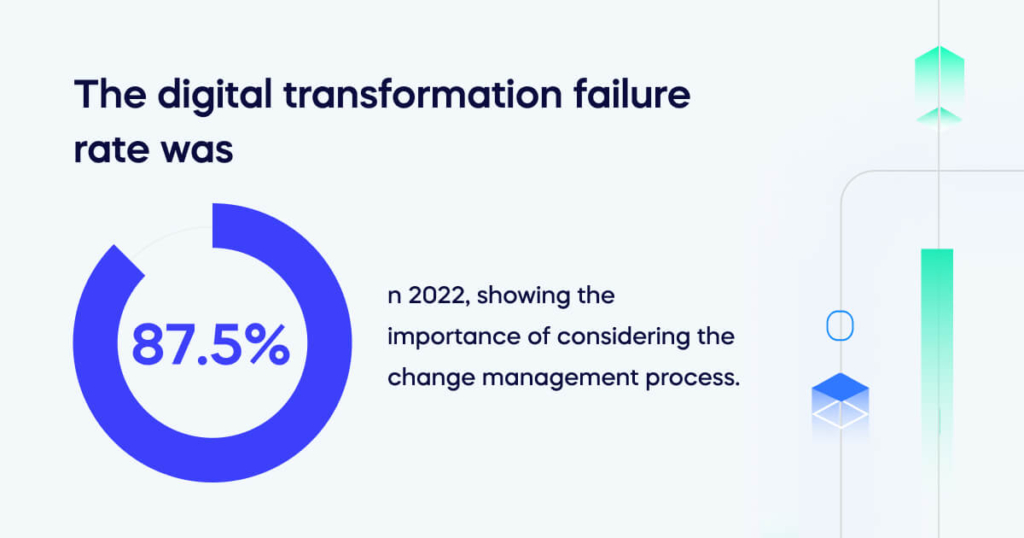
The digital transformation failure rate was 87.5% in 2022, showing the importance of considering the change management process. It will help you ensure ROI and success in managing how your staff reacts to change for transformation success.
In this article, we will explore the change management process via the following topics:
- What is the change management process?
- Why is the change management process important?
- Change management process challenges
- What are the 7 steps of the change management process?
What is the change management process?

The change management process involves the phases encompassed in any strategy for managing and executing change. Having a plan and clear steps leads to successful changes and ensures a thorough examination of all factors.
For instance, integrating fresh technology into a company will encompass more than technological alteration. It could impact workforce size, necessitate structural adjustments, initiate new hiring efforts, or lead to staff reductions.
Substantial measures might be essential for training and to mitigate business expenses. Change management processes cover a broad spectrum of considerations.
The change management process consists of 7 steps:
- Define your vision
- Include stakeholders
- Incorporate change into your plans
- Strong communication
- Risks and resistance
- Celebrate success
- Review, repeat, and implement
Why is the change management process important?
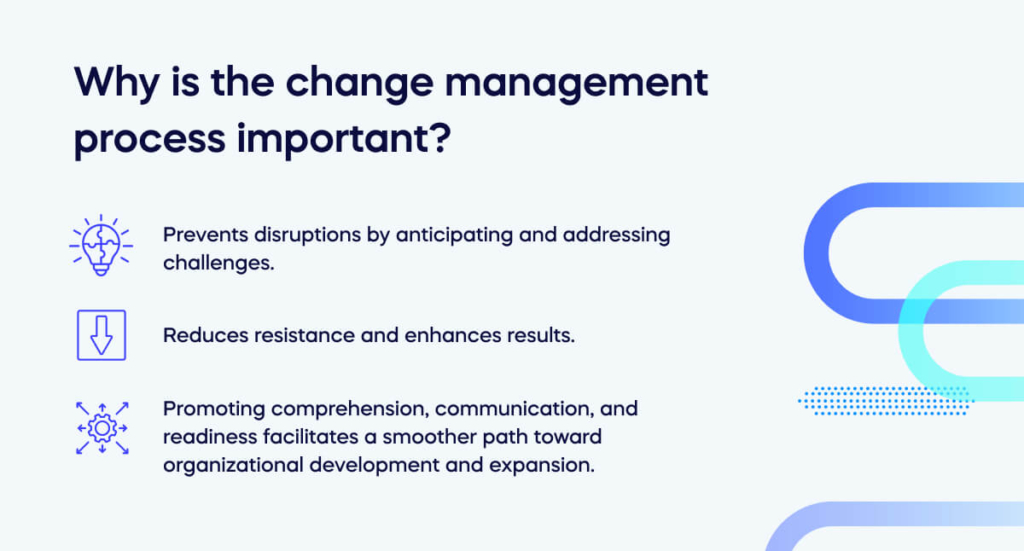
The significance of the change management process lies in its ability to guide organizational transitions smoothly as they implement change.
This procedure goes deeper, exploring the diverse aspects affected by alterations. It prevents disruptions by anticipating and addressing challenges.
Whether it involves new technology adoption, restructuring, or process changes, change management reduces resistance and enhances results.
Promoting comprehension, communication, and readiness facilitates a smoother path toward organizational development and expansion.
Change management process challenges
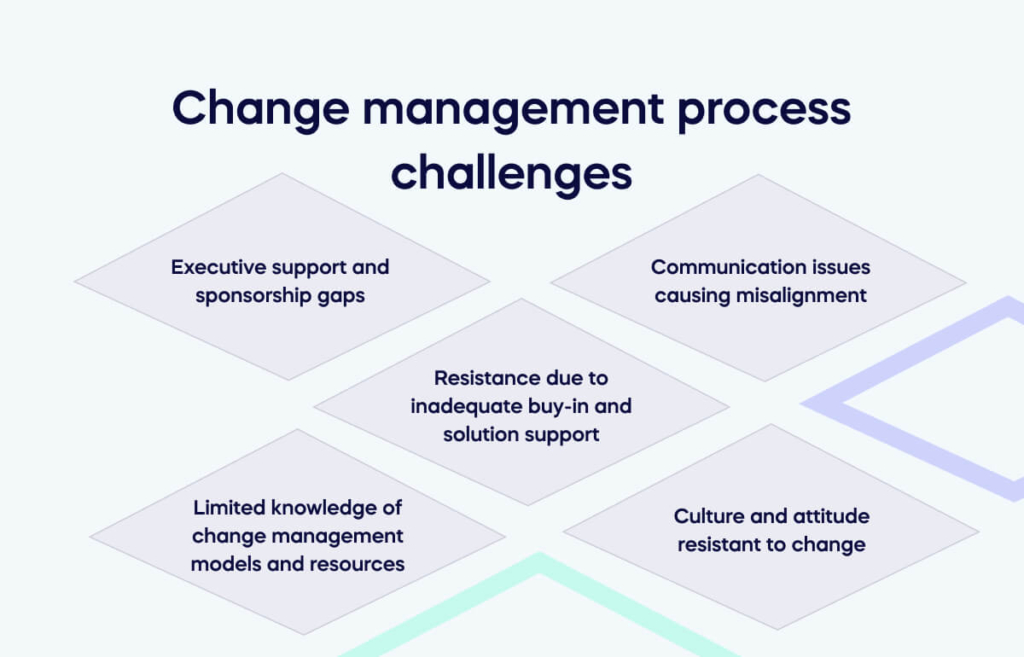
Consider the challenges of the change management process to ensure success in your change management efforts.
1. Executive support and sponsorship gaps
Many executives need a clearer understanding of their role, required resources, and the purpose of change. Gaining this understanding leads to consistent and transparent communication.
These problems also result in dwindling support post-implementation, a lack of buy-in, and infrequent engagement, a significant obstacle.
Effective sponsorship can drive change, while poor support hinders progress, sending signals about the initiative’s importance to employees.
2. Communication issues causing misalignment
Ineffective communication, lacking transparency and alignment with organizational goals, leads to confusion and misalignment among affected groups.
This environment necessitates additional efforts to clarify roles, set expectations, and secure buy-in to achieve key performance indicators.
Preferred senders play a crucial role in effective communication, with employees preferring business-level messages from top leaders and personal messages from their immediate supervisors.
3. Resistance due to inadequate buy-in and solution support
Those most likely to resist change often exhibit limited engagement and a reluctance to adopt new processes due to fear of the unknown.
They may be comfortable with the status quo and lack the desire to embrace change. Resistance often stems from a lack of understanding of the business reasons for the change.
Creating buy-in involves articulating a compelling “why” for the change, addressing the business rationale, and answering “What’s in it for me?” (WIIFM) for each employee.
4. Limited knowledge of change management models and resources
Many organizations lack knowledge about change management and its value. Doing so hinders securing the necessary resources and budget for successful change initiatives.
Leadership and managers may be reluctant to allocate resources because they don’t perceive the value of change management or know which change management models to use.
Leaders can hire change management consultants to help them select the best change management model for their change initiative and organization, using this to develop their organizational change management strategy.
Adequate resourcing is essential for achieving project objectives, and change management should align with the scope and scale of the change.
5. Culture and attitude resistant to change
Organizations with a history of failed changes, siloed departments, and resistant behaviors toward implementing change suffer from lower performance, trust, and engagement.
A company culture marked by negative attitudes and internal politics promotes individual priorities and resistance to change.
Transforming this culture requires a shift in employee mindsets.
Managing resistance is crucial within a structured change management approach, especially in environments prone to resistance due to complex histories or political dynamics.
What are the 7 steps of the change management process?
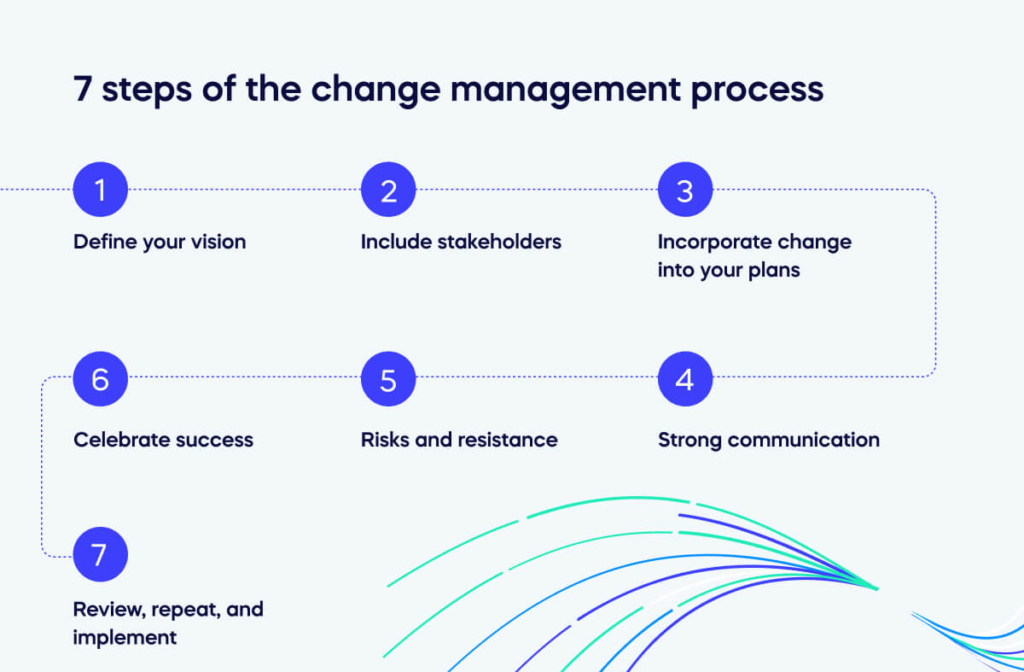
The change management process involves seven steps to success, beginning with defining your vision.
1. Define your Vision
Every effective change management process starts with a vision.
Your vision is the foundation for future success, and it is where you’ll clarify your intentions and gain an understanding of what you’re seeking to improve.
Once you map out your vision, you’ll recognize the resources and people who will facilitate the process and offer strong change leadership.
This vision will be the basis for your change management guide, creating clarity and ease for a successful implementation by every change management team member.
2. Include stakeholders
Stakeholders are those who have an active interest in implementing the change.
There are several layers to consider, from those who will enact the change process as part of their daily routine to those who drive the initiatives.
A DAP (digital adoption platform) is one of the best ways to include stakeholders by showing them the basics of the planned changes. When staff understand the changes, they can give feedback and ways to improve them.
While each change framework requires different encouragement, the common factors always require patience, time, and communication.
3. Incorporate change into your plans
A critical part of your change management process is establishing a route to success. This step begins with ambition, where you must set an end goal.
Identifying the resources necessary to get there, including tools and funding, is difficult.
Leverage data to provide clarity, with transparent reporting that allows for better communication regarding achieving milestones. Coordinate through a multi-step process.
Outline your project with clear steps, implementing measurable targets, incentives, and analysis. Patience is critical throughout all change management.

Avoid rushing into unplanned ‘sweeping’ changes that can do more harm than good. Avoid shortcuts, and devise a comprehensive plan with realistic targets.
4. Utilize strong communication
Communication is the cornerstone of any successful change management process.
The golden thread ties everything together — any objective is within reach if you create the right dialogue.
Good communication helps you navigate through the fears and frustration that change may incite.
Humans naturally fear the unknown, and strong communication can help break down that barrier.
Transparency and two-way communication allow staff to express their frustrations and give each change leader time to modify strategy accordingly.
Clear communication channels align employees’ ambitions with the company’s best interests.
5. Address risks and resistance
Resistance to change is usually present, but when you don’t manage it proactively, it can threaten the success of your project.
Most staff will perceive change as risky, but leaders can positively influence perceptions even when employees understand risks and their impact on the organization from the perspective of their role.
You’ll have to consider the risk of allocating your budget to something new, impacting dependencies, and the return on investment risks.
Ultimately, staff should be encouraged to embrace risk to receive rewards.
With the correct tools to manage a smooth change life-cycle, you can mitigate the negative impact of resistance and risks.
6. Celebrate Success
Recognizing milestone achievements is crucial to ensuring you’re moving in the right direction.
You should reinforce positive behaviors, those that contribute to your overarching goals. When staff have incentives to meet company objectives, their motivations will fit with the change goals.
Recognize your team’s success throughout proceedings since this will help with the adoption of your change management process and the change itself.
7. Review, Repeat, and Improve
Change is difficult but an ongoing process, where constant adjustments are necessary to meet ever-evolving consumer and business needs.
Your ability to review your change strategy will define its potency, particularly in identifying and removing roadblocks. Repeat positive steps, and modify things according to your data and KPIs.
Your process is only as good as its commitment to analysis, and once you’ve implemented something beneficial, you can repeat it.
Ensure change management process success with a DAP
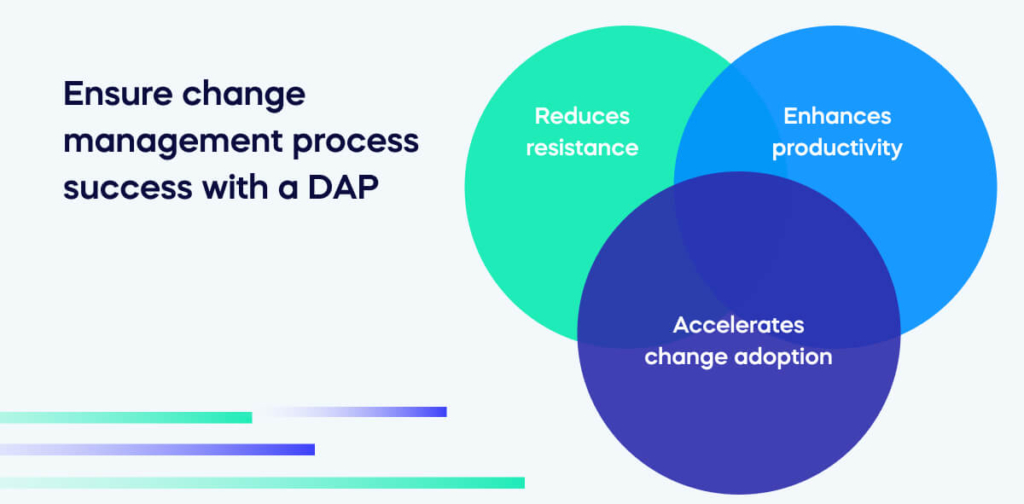
Effective change management is essential for staying competitive in today’s fast-paced business environment. One powerful tool to ensure success in this endeavor is a Digital Adoption Platform (DAP).
A DAP provides real-time, context-sensitive guidance to users, helping them seamlessly transition to new technologies and processes. Doing so reduces resistance, enhances productivity, and accelerates change adoption.
By incorporating a DAP into their change management strategy, businesses can streamline the process, drive successful implementations, and stay agile in the face of evolving challenges.

